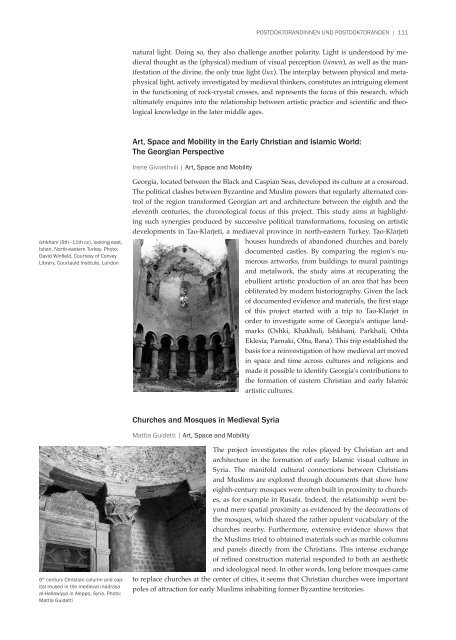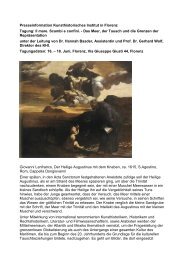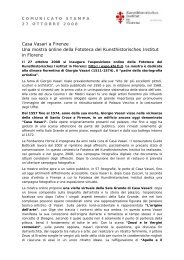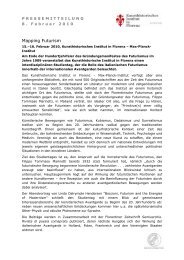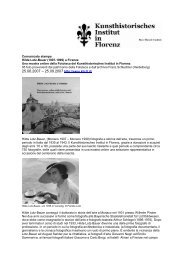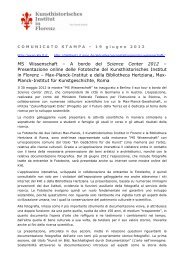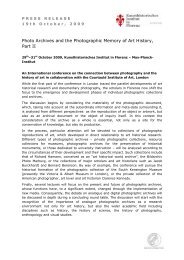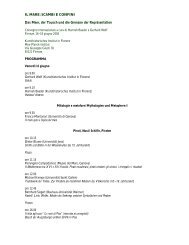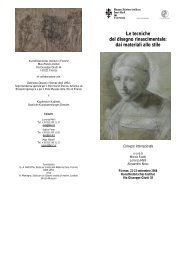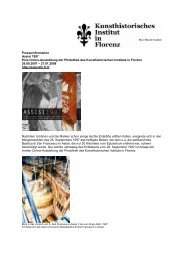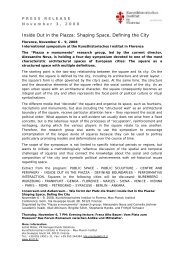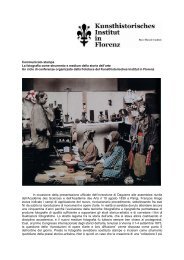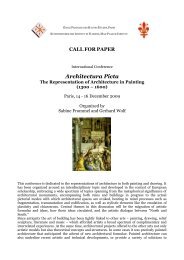forschungsbericht november 2008 – juli 2012 - Kunsthistorisches ...
forschungsbericht november 2008 – juli 2012 - Kunsthistorisches ...
forschungsbericht november 2008 – juli 2012 - Kunsthistorisches ...
Sie wollen auch ein ePaper? Erhöhen Sie die Reichweite Ihrer Titel.
YUMPU macht aus Druck-PDFs automatisch weboptimierte ePaper, die Google liebt.
POSTDOKTORANDINNEN UND POSTDOKTORANDEN | 111<br />
natural light. Doing so, they also challenge another polarity. Light is understood by medieval<br />
thought as the (physical) medium of visual perception (lumen), as well as the manifestation<br />
of the divine, the only true light (lux). The interplay between physical and metaphysical<br />
light, actively investigated by medieval thinkers, constitutes an intriguing element<br />
in the functioning of rock-crystal crosses, and represents the focus of this research, which<br />
ultimately enquires into the relationship between artistic practice and scientific and theological<br />
knowledge in the later middle ages.<br />
Art, Space and Mobility in the Early Christian and Islamic World:<br />
The Georgian Perspective<br />
Irene Giviashvili | Art, Space and Mobility<br />
Ishkhani (9th<strong>–</strong>11th cc), looking east,<br />
Ishan, North-eastern Turkey. Photo:<br />
David Winfield, Courtesy of Convey<br />
Library, Courtauld Institute, London<br />
Georgia, located between the Black and Caspian Seas, developed its culture at a crossroad.<br />
The political clashes between Byzantine and Muslim powers that regularly alternated control<br />
of the region transformed Georgian art and architecture between the eighth and the<br />
eleventh centuries, the chronological focus of this project. This study aims at highlighting<br />
such synergies produced by successive political transformations, focusing on artistic<br />
developments in Tao-Klarjeti, a mediaeval province in north-eastern Turkey. Tao-Klarjeti<br />
houses hundreds of abandoned churches and barely<br />
documented castles. By comparing the region's numerous<br />
artworks, from buildings to mural paintings<br />
and metalwork, the study aims at recuperating the<br />
ebullient artistic production of an area that has been<br />
obliterated by modern historiography. Given the lack<br />
of documented evidence and materials, the first stage<br />
of this project started with a trip to Tao-Klarjet in<br />
order to investigate some of Georgia's antique landmarks<br />
(Oshki, Khakhuli, Ishkhani, Parkhali, Othta<br />
Eklesia, Parnaki, Oltu, Bana). This trip established the<br />
basis for a reinvestigation of how medieval art moved<br />
in space and time across cultures and religions and<br />
made it possible to identify Georgia's contributions to<br />
the formation of eastern Christian and early Islamic<br />
artistic cultures.<br />
Churches and Mosques in Medieval Syria<br />
Mattia Guidetti | Art, Space and Mobility<br />
6 th century Christian column and capital<br />
reused in the medieval madrasa<br />
al-Hallawiyya in Aleppo, Syria. Photo:<br />
Mattia Guidetti<br />
The project investigates the roles played by Christian art and<br />
architecture in the formation of early Islamic visual culture in<br />
Syria. The manifold cultural connections between Christians<br />
and Muslims are explored through documents that show how<br />
eighth-century mosques were often built in proximity to churches,<br />
as for example in Rusafa. Indeed, the relationship went beyond<br />
mere spatial proximity as evidenced by the decorations of<br />
the mosques, which shared the rather opulent vocabulary of the<br />
churches nearby. Furthermore, extensive evidence shows that<br />
the Muslims tried to obtained materials such as marble columns<br />
and panels directly from the Christians. This intense exchange<br />
of refined construction material responded to both an aesthetic<br />
and ideological need. In other words, long before mosques came<br />
to replace churches at the center of cities, it seems that Christian churches were important<br />
poles of attraction for early Muslims inhabiting former Byzantine territories.


